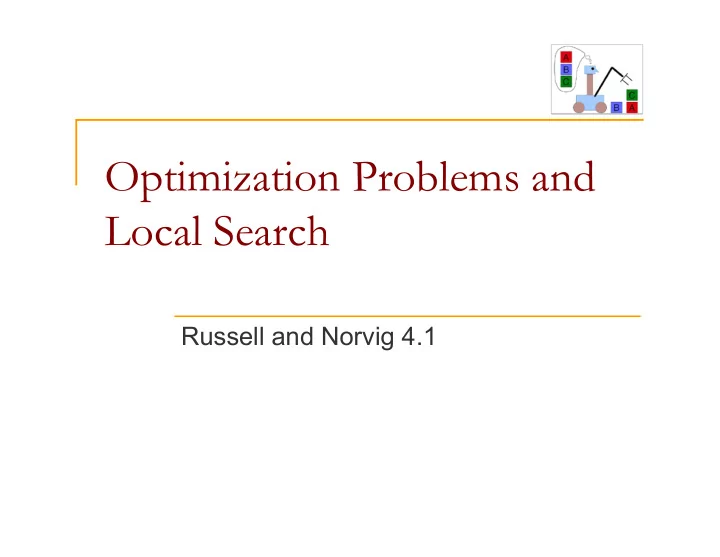

Optimization Problems and Local Search Russell and Norvig 4.1
Optimization Problems n Previously: systematic exploration of search space. q Path to goal is the solution n For some problems path is irrelevant. q Example: 8-queens
8 Queens Stated as an optimization problem: n State space: a board with 8 queens on it n Objective/cost function: Number of pairs of queens that are attacking each other (quality of the state).
The Traveling Salesman Problem (TSP) TSP: Given a list of cities and their pairwise distances, find a shortest possible tour that visits each city exactly once. 13,509 cities and towns in the US that An optimal TSP tour through have more than 500 residents Germany’s 15 largest cities (one out of 14!/2) http://www.tsp.gatech.edu/
The Traveling Salesman Problem (TSP) TSP: Given a list of cities and their pairwise distances, find a shortest possible tour that visits each city exactly once. States? Cost function?
Local Search 18 12 14 13 13 12 14 14 14 16 13 15 12 14 12 16 14 12 18 13 15 12 14 14 15 14 14 13 16 13 16 14 17 15 14 16 16 17 16 18 15 15 18 14 15 15 14 16 14 14 13 17 12 14 12 18 n Keep a current state, try to improve it by “locally” exploring the space of solutions n Improve state by moving a queen to a position where fewer queens attack each other (neighboring state) n Neighbors: move a queen in its column
Greedy local search n Problem: can get stuck in a local minimum (happens 86% of the time for the 8-queens problem).
Local minima vs. local maxima n Local search: find a local maximum or minimum of an objective function (cost function). n local minima of a function f(n) are the same of the maxima of -f(n) . Therefore, if we know how to solve one, we can solve the other.
Hill-climbing Try all neighbors and keep moves that improve the objective function the most objective function global maximum plateau shoulder local maximum “flat” local maximum state space current state
Hill-climbing function HILL-CLIMBING( problem ) return a state that is a local maximum current ← MAKE-NODE(problem.INITIAL-STATE) loop do neighbor ← a highest valued successor of current if neighbor.VALUE ≤ current. VALUE then return current.STATE current ← neighbor This flavor of hill-climbing is known as steepest ascent (steepest descent when the objective is minimization) Finds local optimum 86% of the time for 8 queens problem.
Hill-climbing Try all neighbors and keep moves that improve the objective function the most What makes plateaus objective function global maximum a challenge for hill-climbing? plateau shoulder local maximum “flat” local maximum state space current state
Formulating a problem as a local search problem What you need to decide on: n The possible states and their representation n Choice of initial state n Choice of neighborhood of a state q The neighborhood should be rich enough such that you don’t get stuck in bad local optima q It should be small enough so that you can efficiently search the neighbors for the best local move
Solving TSP Need to design a neighborhood that yields valid tours A 2-opt move:
3-opt n Choose three edges from tour n Remove them, and combine the three parts to a tour in the cheapest way to link them C B D A F E Source: University of Utrecht, www.cs.uu.nl/docs/vakken/na/na2-2005.ppt
Solving TSP (cont.) n 3-opt moves lead to better local minima than 2-opt moves. n The Lin-Kernighan algorithm (1973): a λ -opt move - constructs a successor that changes λ cities in a tour n Often finds optimal solutions. n The best algorithm for TSP until 1989.
Variations of hill climbing n Steepest ascent: choose the neighbor with the largest increase in objective function. n Stochastic hill-climbing q Random selection among the uphill moves. q The selection probability can vary with the steepness of the uphill move. n First-choice hill-climbing q Stochastic hill climbing, generating successors randomly until a better one is found. n Random-restart hill-climbing q Choose best among several hill-climbing runs, each from a different random initial state.
Random Restart n Suppose that the probability of failure in a single try is P f n The probability of failure in k trials: P f (k trials) = (P f ) k P s (k trials) = 1 – P f (k trials) = 1 - (P f ) k n The probability of success can be made arbitrarily close to 1 by increasing k. n Example: For the eight queens problem P s (100 trials) = 0.9999997
Hill climbing for NP-complete problems n NP-complete problems can have an exponential number of local minima. n But: q Most instances might be easy to solve q Even if we can’t find the optimal solution, a reasonably good local maximum can often be found after a small number of restarts.
Recommend
More recommend